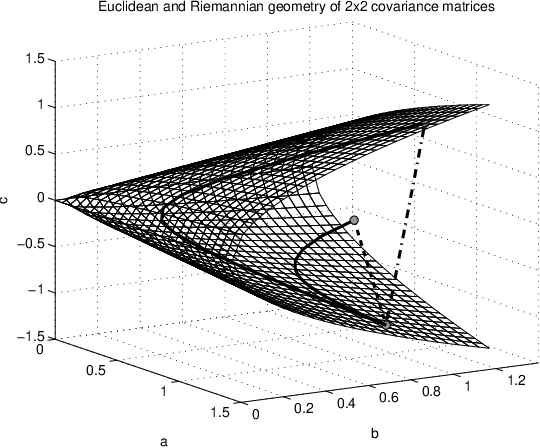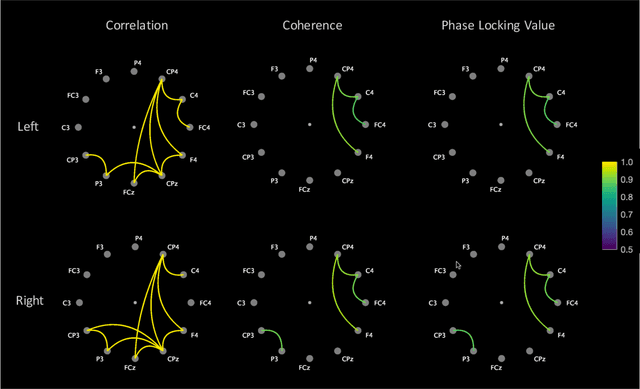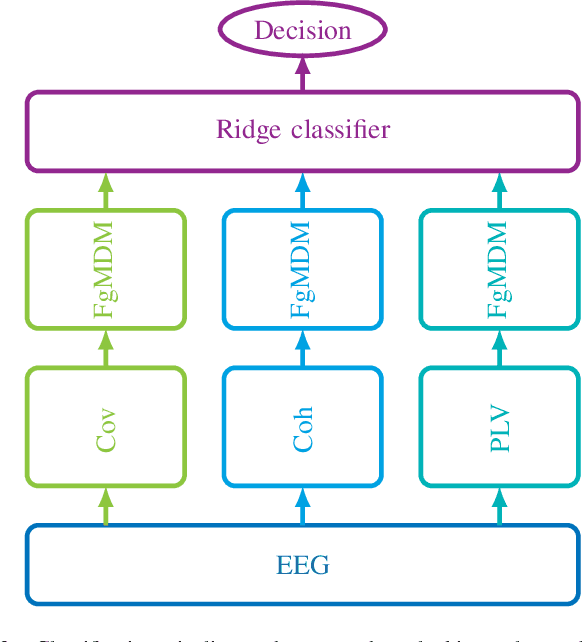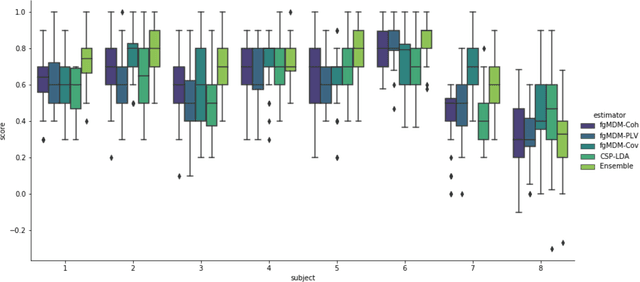Camille Noûs
Minimizing subject-dependent calibration for BCI with Riemannian transfer learning
Nov 23, 2021



Abstract:Calibration is still an important issue for user experience in Brain-Computer Interfaces (BCI). Common experimental designs often involve a lengthy training period that raises the cognitive fatigue, before even starting to use the BCI. Reducing or suppressing this subject-dependent calibration is possible by relying on advanced machine learning techniques, such as transfer learning. Building on Riemannian BCI, we present a simple and effective scheme to train a classifier on data recorded from different subjects, to reduce the calibration while preserving good performances. The main novelty of this paper is to propose a unique approach that could be applied on very different paradigms. To demonstrate the robustness of this approach, we conducted a meta-analysis on multiple datasets for three BCI paradigms: event-related potentials (P300), motor imagery and SSVEP. Relying on the MOABB open source framework to ensure the reproducibility of the experiments and the statistical analysis, the results clearly show that the proposed approach could be applied on any kind of BCI paradigm and in most of the cases to significantly improve the classifier reliability. We point out some key features to further improve transfer learning methods.
Calling to CNN-LSTM for Rumor Detection: A Deep Multi-channel Model for Message Veracity Classification in Microblogs
Oct 11, 2021



Abstract:Reputed by their low-cost, easy-access, real-time and valuable information, social media also wildly spread unverified or fake news. Rumors can notably cause severe damage on individuals and the society. Therefore, rumor detection on social media has recently attracted tremendous attention. Most rumor detection approaches focus on rumor feature analysis and social features, i.e., metadata in social media. Unfortunately, these features are data-specific and may not always be available, e.g., when the rumor has just popped up and not yet propagated. In contrast, post contents (including images or videos) play an important role and can indicate the diffusion purpose of a rumor. Furthermore, rumor classification is also closely related to opinion mining and sentiment analysis. Yet, to the best of our knowledge, exploiting images and sentiments is little investigated.Considering the available multimodal features from microblogs, notably, we propose in this paper an end-to-end model called deepMONITOR that is based on deep neural networks and allows quite accurate automated rumor verification, by utilizing all three characteristics: post textual and image contents, as well as sentiment. deepMONITOR concatenates image features with the joint text and sentiment features to produce a reliable, fused classification. We conduct extensive experiments on two large-scale, real-world datasets. The results show that deepMONITOR achieves a higher accuracy than state-of-the-art methods.
MONITOR: A Multimodal Fusion Framework to Assess Message Veracity in Social Networks
Sep 06, 2021



Abstract:Users of social networks tend to post and share content with little restraint. Hence, rumors and fake news can quickly spread on a huge scale. This may pose a threat to the credibility of social media and can cause serious consequences in real life. Therefore, the task of rumor detection and verification has become extremely important. Assessing the veracity of a social media message (e.g., by fact checkers) involves analyzing the text of the message, its context and any multimedia attachment. This is a very time-consuming task that can be much helped by machine learning. In the literature, most message veracity verification methods only exploit textual contents and metadata. Very few take both textual and visual contents, and more particularly images, into account. In this paper, we second the hypothesis that exploiting all of the components of a social media post enhances the accuracy of veracity detection. To further the state of the art, we first propose using a set of advanced image features that are inspired from the field of image quality assessment, which effectively contributes to rumor detection. These metrics are good indicators for the detection of fake images, even for those generated by advanced techniques like generative adversarial networks (GANs). Then, we introduce the Multimodal fusiON framework to assess message veracIty in social neTwORks (MONITOR), which exploits all message features (i.e., text, social context, and image features) by supervised machine learning. Such algorithms provide interpretability and explainability in the decisions taken, which we believe is particularly important in the context of rumor verification. Experimental results show that MONITOR can detect rumors with an accuracy of 96% and 89% on the MediaEval benchmark and the FakeNewsNet dataset, respectively. These results are significantly better than those of state-of-the-art machine learning baselines.
RIGOLETTO -- RIemannian GeOmetry LEarning: applicaTion To cOnnectivity. A contribution to the Clinical BCI Challenge -- WCCI2020
Mar 11, 2021



Abstract:This short technical report describes the approach submitted to the Clinical BCI Challenge-WCCI2020. This submission aims to classify motor imagery task from EEG signals and relies on Riemannian Geometry, with a twist. Instead of using the classical covariance matrices, we also rely on measures of functional connectivity. Our approach ranked 1st on the task 1 of the competition.
 Add to Chrome
Add to Chrome Add to Firefox
Add to Firefox Add to Edge
Add to Edge